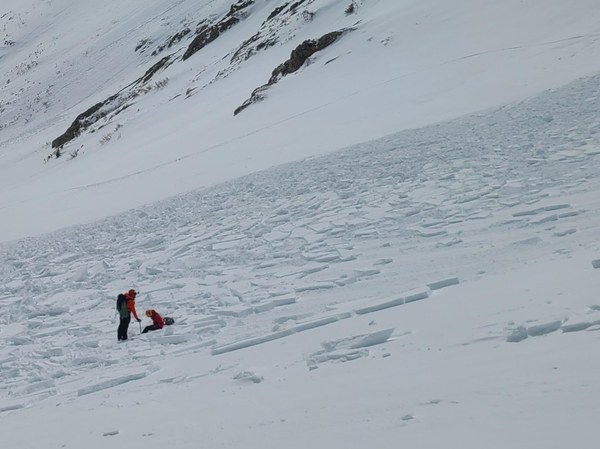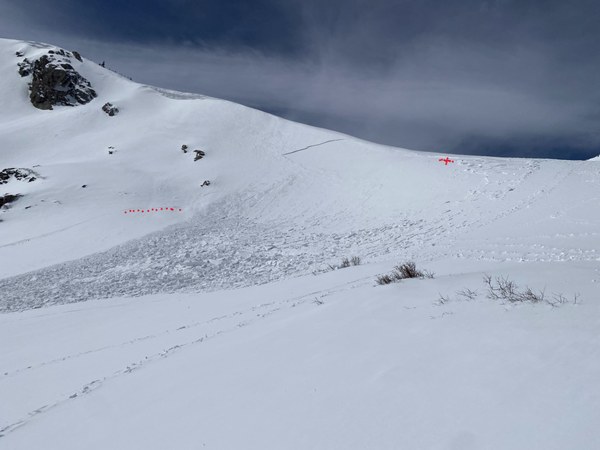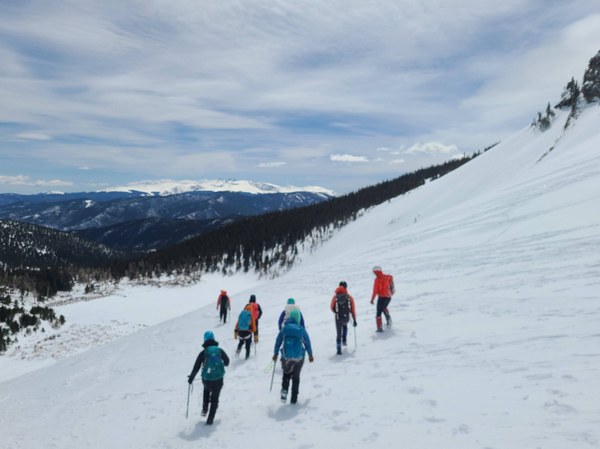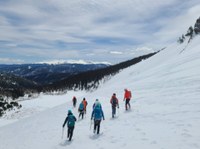On Sunday, April 6, 2025, during an Alpine Climbing School (ACS) Intermediate Snow Field Day at St. Mary's Glacier, a shallow wind slab avalanche occurred on what appeared to be low-angle, low-consequence terrain. The incident took place at approximately 2:00 PM as the group was preparing for a final glissade exercise after completing their training sessions. Two individuals—an instructor and a student—were caught in the slide but fortunately were not buried and walked away without injuries. The slide area was approximately 75' x 200' with a depth of one to two feet.

Incident Details
The ACS group consisted of five Team Track students, two modular students, and four instructors, many with significant experience including AIARE training. The trip leader had conducted appropriate pre-trip preparation, including reviewing Colorado Avalanche Information Center (CAIC) reports and postponing the trip by one day due to avalanche conditions.
As described in the incident report, the group "began with a stop in the forest where we donned crampons and did a review of avalanche rescue procedures." All participants were equipped with avalanche safety gear, and proper beacon checks were conducted before heading up toward the glacier.
The slide occurred in an area frequently used for glissade practice, where this type of incident had not previously been observed by experienced instructors. Weather conditions included recent snowfall (approximately one foot) and gusty winds, with CAIC forecasting "moderate" avalanche risk for April 6th.

CAIC Forecast Context
The CAIC forecast for Sunday, April 6th indicated "Moderate" avalanche danger at all elevations. The forecast specifically warned: "You could still trigger a small avalanche in wind-drifted snow at high elevations. These would be particularly concerning in steep consequential terrain. Observing cracks in the snow is a sign to avoid particular slopes."
The forecast also cautioned: "Avoid steep slopes getting direct sunlight that have not already shed snow. Within a couple of hours of sun, about 2 feet of cold snow above the crust is likely to be shed. Southerly slopes will be the most hazardous."

SCHOOL Commentary
AIARE instructor Ken Yaphe notes that this incident provides important learning opportunities for the entire CMC community. He emphasizes, "Most importantly is that [the trip leader] has handled this with his team and ACS well. Own it, discuss it, engage in serious introspection, and share it... His discussion should serve as a model for the CMC instructor cohort."
Yaphe also raises important questions about required training: "The incident does raise the question about required training for instructors/students. In my conversation with [the trip leader], it seems there is still ambiguity as to what level of knowledge is required by whom and when for ACS (for instructors and students)."
AIARE instructor Uwe Sartori highlights the importance of thorough data collection and analysis: "Better to have collected the data points from a tracking perspective to really do a thoughtful analysis... The AM/PM reports force a better analysis and discussion." Sartori also points out how quickly conditions can change, noting, "On Friday afternoon, other CAIC avalanche danger forecast for Sunday was Considerable. On Saturday's forecast they restated Sunday as Moderate, and added avalanche problem #2 - Loose Wet."
Key Takeaways for CMC Leaders
Equipment & Training
- Beacon, probe, and shovel are required for all participants and students on when traveling in avalanche prone terrain.
- Never assume all participants know how to use their equipment properly, even those with formal avalanche training.
Trip Planning & Assessment
- Review CAIC forecasts and conditions in the days leading up to your trip.
- Consider implementing a formal AM Snow Operations Report before departing for field days.
- Be willing to postpone or relocate trips based on conditions.
- Remember that St. Mary's Glacier, as Sartori noted, "is a wind tunnel" and conditions can change rapidly.
Continuous Risk Assessment
- Regularly reassess conditions throughout your trip, especially when weather is changing.
- Remember that wind can transform snow conditions quickly, even at lower elevations.
- Be particularly cautious of wind-loaded slopes, regardless of angle.
- As the CAIC forecast warned, "Observing cracks in the snow is a sign to avoid particular slopes."
Clear Communication
- Discuss avalanche conditions and potential risk areas with your group.
- Involve experienced participants in hazard identification.
- Establish clear protocols for what to do in case of an avalanche.
Incident Reporting
- Report all incidents promptly using the CMC incident reporting system, even when no injuries occur.
- As Ken Yaphe noted, this may indicate "the need for a different type of report (i.e., a 'near miss' report)."
- Consider submitting reports to CAIC (even for non-injury incidents).
- Share incident information promptly with all relevant CMC stakeholders.
Conclusion
This incident serves as an important reminder that even in familiar terrain with experienced leaders, alpine environments present inherent and sometimes subtle risks. As the trip leader reflected, "A fun glissade would have capped off a great day. Instead we all got an unintended lesson. Frightening - but the takeaway should be recognition that the alpine environment has inherent risks. Some very subtle."
We commend the leader and co-leaders of this trip for their appropriate preparation, response, and thorough debrief following the incident. By maintaining vigilance, following established protocols, and learning from incidents, we can continue to mitigate risks while enjoying Colorado's mountain environments.
The Colorado Mountain Club remains committed to providing safe and educational outdoor experiences. Please reach out to the CMC Safety Committee with any questions or for additional guidance on avalanche safety protocols.
 Graham Ottley
Graham Ottley

Add a comment
Log in to add comments.Was a snow pit dug and layer analysis conducted (in advance of occupying the area) where the slope was where the class was being conducted? A forecast change from "considerable" to "moderate" in 24 to 36 hours is a big shift in risk.
Really appreciate this analysis. Been going to that spot for years. Never seen it slide.